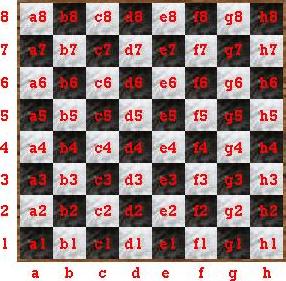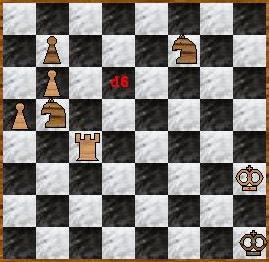| Idiot-proof chess help | |
Affiliates Navigation |
Algebraic Notation
Algebraic notation is one of the many forms of notation used to write down chess games, although it is both the most-used, and the system that has been adopted for tournaments, and it is also used in most chess books. In algebraic Notation, each move written down consists of three basic things: the move number, the name of the piece, and the square to which it is moving (Long Algebraic Notation also includes the square on which the piece starts). The move number is the number of the move in the game (or of a particular extract from a game), so the first move of the game would be 1, the second 2 etc.The letter names of the pieces are as follows: King: KQueen: Q Bishop: B Knight: N Rook: R The pawn has no letter, as it's not a piece (although P is sometimes used). Each square is assigned a 'name', depending on its position on the board. The rows of squares are called files, and the columns are called ranks. The files are each given a letter from a to h, from White's left to White's right; the ranks are numbered 1 to 8, 1 being nearest to White and 8 being nearest to Black: So, it's fairly simple: A Knight moving to g5 on the seventh move of the game would be written as 7. Ng5. When a capture is made, an x is inserted between the piece and the square to which it is moving, so if the Knight in the previous example was capturing, the move would be written as 7. Nxg5. If a pawn captures, the file on which the pawn was standing is written, so if the e-pawn were to capture the f-pawn (on f5) on the second move of the game, it would be written as 2. exf5.OTHER SYMBOLS USED If a piece gives check, a + sign is added at the end of the move, so if the Knight were giving check, the move would be written as 7. Nxg5+; likewise, ++ is used for double check, and for checkmate, either #, Checkmate or mate can be used, so if the above example was checkmate, it could be 7. Nxg5#, 7. Nxg5 Checkmate or 7. Nxg5 mate. Stalemate is written as Stalemate.Kingside castling is written as o-o, and queenside castling as o-o-o. Sometimes, the following symbols are used at the end of the move:
! = excellent move (e.g. 1. Ne6!), One last thing: What if more than one piece can make a move, as here, where it is possible for bothBlack Knights to play: 1...Nd6:  Well, you specify which piece makes the move by putting the letter of the file on which it stands after the letter of the piece, so if the Knight on f7 were to move to d6, it would be written down as 1...Nfd6, and if the one on c4 were to make the move, it would be 1...Ncd6. If both pieces stand on the same file e.g. if the c4-Knight were on f5, you specify the rank instead: 1...N5d6 or 1...N7d6. Here we have a short sample game in this notation (And no, I don't know why I even tried the Scholar's Mate!):C. STOKES vs. T. DENTON c. 2004 1. e4 e52. Bc4 a6 3. Qf3 c6 4. Qxf7# 1-0 See that 1-0 that I added to the end of the game? That indicates a White victory: 0-1 would be a Black victory; ½-½ would be a draw. Remember to explore the rest of my site!© 2004-2007 Chess Resources King. All rights reserved. |